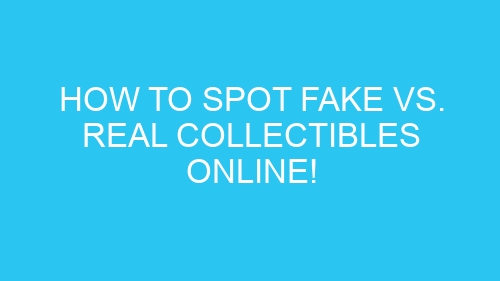-
Table of Contents
Identifying Authenticity: Key Factors to Look for in Collectibles Online
Are you an avid collector? Do you spend hours scouring the internet for that perfect addition to your collection? Well, my friend, you’ve come to the right place! In this article, we’re going to dive deep into the world of collectibles and discuss how to spot fake vs. real items online. So grab your magnifying glass and let’s get started!
Now, before we begin, let’s establish one thing: the internet is a vast and treacherous place when it comes to collectibles. It’s like a virtual jungle filled with counterfeiters and scammers just waiting to pounce on unsuspecting collectors. But fear not! With a little knowledge and a keen eye, you can navigate this treacherous terrain and come out on top.
The first thing you need to do when trying to identify the authenticity of a collectible online is to examine the photos. And I don’t mean just a quick glance. I’m talking about a thorough inspection worthy of Sherlock Holmes himself. Look for any signs of tampering or manipulation. Are the colors too vibrant? Are there any suspicious shadows? If something seems off, it probably is.
Next, take a close look at the item’s description. Is it detailed and accurate? Or does it read like a poorly written fanfiction? Authentic sellers will provide you with all the necessary information about the item, including its history, condition, and any flaws it may have. If the description is vague or filled with grammatical errors, it’s a red flag.
Now, let’s talk about price. We all love a good deal, but when it comes to collectibles, if something seems too good to be true, it probably is. Counterfeiters often lure unsuspecting collectors with ridiculously low prices, hoping to make a quick buck. So, if you stumble upon a rare item at a fraction of its market value, proceed with caution.
Another key factor to consider is the seller’s reputation. Do they have a long history of positive feedback? Or are they a newbie with no track record? A reputable seller will have a solid reputation and a loyal customer base. So, before you hit that “buy now” button, take a moment to read through the seller’s reviews. If there are any red flags or negative comments, it’s best to steer clear.
Now, let’s talk about the importance of research. As a collector, it’s your duty to educate yourself about the items you’re interested in. Familiarize yourself with the market value, the different variations, and any telltale signs of authenticity. The more you know, the better equipped you’ll be to spot a fake.
Lastly, trust your gut. As collectors, we have a sixth sense when it comes to our beloved items. If something doesn’t feel right, listen to that little voice inside your head. It’s better to walk away from a potential fake than to end up with a worthless piece of junk.
So there you have it, my fellow collectors. Armed with these key factors, you can now venture into the wild world of collectibles online with confidence. Remember, it’s a jungle out there, but with a little knowledge and a dash of humor, you’ll be able to separate the real gems from the counterfeit duds. Happy collecting!
Red Flags to Watch Out for When Buying Collectibles Online
Are you an avid collector? Do you spend hours scouring the internet for that perfect addition to your collection? Well, my friend, you are not alone. The online world has become a treasure trove for collectors, offering a vast array of rare and unique items just a click away. But, as with any treasure hunt, there are bound to be a few fake gems lurking in the shadows. Fear not, for I am here to guide you through the treacherous waters of online collectible shopping and help you spot the fakes from the real deal.
Now, let’s dive right in and explore the red flags you should watch out for when buying collectibles online. First and foremost, beware of the overly enthusiastic seller. You know the type – they claim to have the rarest item in existence, the holy grail of collectibles. They’ll use phrases like “one of a kind” and “never before seen.” Well, my friend, if it sounds too good to be true, it probably is. Trust your gut and proceed with caution.
Next up, let’s talk about the alluringly low price. Ah, the siren song of a bargain. We’ve all fallen victim to its seductive melody at some point. But when it comes to collectibles, be wary of prices that seem too good to be true. Remember, these items are rare and valuable for a reason. If someone is selling a supposedly rare collectible for a fraction of its market value, it’s time to put on your detective hat and start asking questions.
Another red flag to watch out for is the lack of detailed information. A genuine seller will provide you with all the juicy details about the item – its history, provenance, and any flaws or imperfections. If the seller is vague or evasive when you ask for more information, it’s a clear sign that something fishy is going on. Don’t be afraid to dig deeper and demand the answers you deserve.
Now, let’s talk about the photographs. A picture is worth a thousand words, or in this case, a thousand dollars. When buying collectibles online, pay close attention to the quality and clarity of the photographs. If the images are blurry, poorly lit, or only show the item from a distance, it’s a major red flag. Genuine sellers will provide you with high-resolution images that allow you to examine every nook and cranny of the item. If they’re not willing to do so, it’s time to move on.
Last but not least, let’s discuss the seller’s reputation. In the online world, reputation is everything. Before making a purchase, take the time to research the seller. Read reviews, check their ratings, and see what other collectors have to say about their experiences. If the seller has a history of negative feedback or suspicious activities, it’s best to steer clear. Remember, my friend, it’s better to be safe than sorry.
So there you have it, my fellow collectors – a guide to spotting fake vs. real collectibles online. Remember to trust your instincts, ask questions, and do your research. And above all, don’t forget to enjoy the thrill of the hunt. Happy collecting!
Expert Tips for Verifying the Authenticity of Collectibles Purchased Online
Are you an avid collector of rare and valuable items? Do you spend hours scouring the internet in search of that one-of-a-kind piece to add to your collection? If so, then you know the thrill of finding a genuine treasure online. But with the rise of online marketplaces, it has become increasingly difficult to distinguish between real collectibles and clever fakes. Fear not, fellow collectors! In this article, we will share expert tips on how to spot fake versus real collectibles online. So grab your magnifying glass and let’s get started!
First and foremost, trust your instincts. If a deal seems too good to be true, it probably is. Remember, genuine collectibles are rare and valuable, so sellers are unlikely to offer them at rock-bottom prices. So, if you stumble upon a vintage Rolex for a fraction of its market value, proceed with caution. It’s better to be safe than sorry!
Next, pay close attention to the seller’s reputation. Online marketplaces often have a rating system that allows buyers to leave feedback about their experience. Take the time to read through these reviews and look for any red flags. If multiple buyers have complained about receiving counterfeit items, it’s a clear sign that the seller cannot be trusted. Don’t be fooled by a seller with a flashy profile picture and a catchy username – always do your due diligence!
Now, let’s talk about the importance of detailed photographs. Genuine sellers will provide high-quality images that clearly showcase the item from various angles. Look for close-ups that highlight any unique features or markings. If the photos are blurry or only show the item from a distance, it’s a major red flag. After all, if the seller has nothing to hide, why not provide clear and detailed pictures?
Another crucial aspect to consider is the item’s provenance. Genuine collectibles often come with a documented history that traces their origin and ownership. Ask the seller for any supporting documents or certificates of authenticity. If they are unable to provide any, it’s a clear indication that the item may be a fake. Remember, a genuine seller will be more than happy to provide you with all the necessary information to verify the item’s authenticity.
Now, let’s talk about the power of research. Before making a purchase, take the time to educate yourself about the item you’re interested in. Familiarize yourself with its unique characteristics, markings, and any common signs of forgery. This knowledge will empower you to make an informed decision and spot any discrepancies in the item’s description or appearance. Remember, knowledge is power, and in the world of collectibles, it can save you from falling victim to a clever scam.
Last but not least, consider seeking the advice of experts. There are countless online forums and communities dedicated to various types of collectibles. Join these communities and engage with fellow collectors who have years of experience under their belts. They can provide valuable insights and help you navigate the treacherous waters of online collectible shopping. Plus, you might make some new friends along the way!
In conclusion, spotting fake versus real collectibles online requires a combination of intuition, research, and expert advice. Trust your instincts, scrutinize the seller’s reputation, examine detailed photographs, verify the item’s provenance, and arm yourself with knowledge. By following these expert tips, you’ll be well-equipped to separate the genuine treasures from the clever fakes. Happy collecting!

